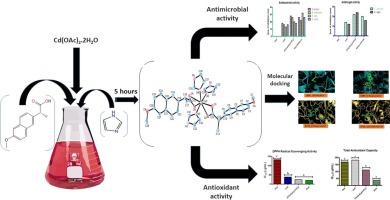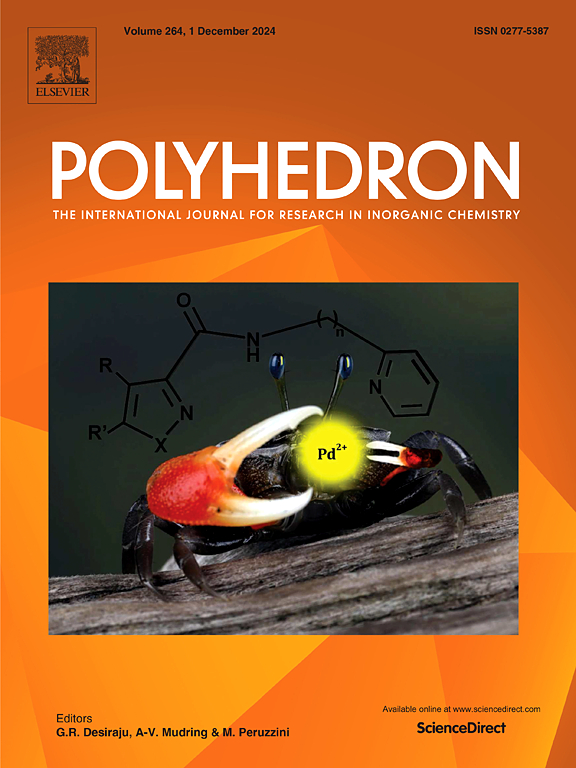含有萘普生和咪唑配体的新型镉(II)配合物:合成、单晶 X 射线、结构阐明、量子化学研究、分子对接、抗氧化和抗菌筛选
IF 2.6
3区 化学
Q2 CHEMISTRY, INORGANIC & NUCLEAR
引用次数: 0
摘要
一种新型混合配体镉(II)配合物[Cd(nap)2(imd)3]已被合成,其中含有萘普生和咪唑配体。该单核复合物的表征通过以下方法进行:1H & 13C NMR、FTIR、UV-vis 和 MS,并通过 SC-XRD 研究验证了其结构。该复合物形成了单斜晶体结构,空间群为 P21,a = 13.581(8) Å,b = 8.290(5) Å,c = 16.693(10) Å,a = γ = 90°,b = 109.352(18)°,V = 1773.1(18) Å3。傅立叶变换红外光谱数据证实,萘乙酸配体通过去质子化氧原子与镉(II)离子结合。围绕镉(II)中心的配位球是一个具有畸变五角双棱锥几何形状的 7 配位体系,其发色团为 CdN3O4,羧酸配体萘普生为双叉配体。与 ADP 核糖基转移酶结合成分蛋白(PDB:6v1s)的对接结果表明,[Cd(nap)2(imd)3] 复合物的结合亲和力为-9.8 kcal/mol,建立了八个氢键,丝氨酸中的氢键长度最短。与阿奇霉素相比,它表现出更大的结合亲和力(-9.5 kcal/mol),并建立了更多的氢键。在与前列腺素还原酶 2(PDB:2zb7)对接过程中检测到的六个氢键相互作用中,酪氨酸 A:100 的键长最短,导致其结合亲和力为-8.6 kcal/mol。相比之下,布洛芬的结合亲和力较低(-7.6 kcal/mol),形成的氢键也较少。总之,分子对接结果有力地表明,[Cd(nap)2(imd)3] 与 ADP 核糖基转移酶结合成分和前列腺素还原酶 2 都有很高的结合亲和力,这表明它有可能成为治疗细菌感染和炎症的候选药物。在体外抗氧化实验中,该复合物的自由基清除活性高于未结合的配体,但低于抗坏血酸标准品。该复合物对一些细菌和真菌菌株有很好的抑制作用。目前的结果可能是由于配体和金属离子在形成复合物过程中的共同作用。本文章由计算机程序翻译,如有差异,请以英文原文为准。

Novel Cd(II) complex bearing naproxen and imidazole ligands: Synthesis, single-crystal X-ray, structural elucidation, quantum chemical investigation, molecular docking, antioxidant and antimicrobial screening
A novel mixed ligand Cd(II) complex [Cd(nap)2(imd)3] bearing naproxen and imidazole ligands have been synthesized. Characterization of the mono-nuclear complex was carried out via: 1H & 13C NMR, FTIR, UV–vis and MS and the structure validated with SC-XRD studies. The complex forms a monoclinic crystal structure with space group P21 and a = 13.581(8) Å, b = 8.290(5) Å, c = 16.693(10) Å, a = γ = 90°, b = 109.352(18)°,V = 1773.1(18) Å3. FTIR data confirmed the binding of the naproxenato ligand via the deprotonated oxygen atom to the cadmium (II) ion. The coordination sphere around the Cd(II) center is a 7-coordinate system with a distorted pentagonal bipyramidal geometry having a CdN3O4 chromophore with bidentate ligation of the carboxylate ligand naproxen. Docking with the ADP-ribosyl transferase binding component protein (PDB: 6v1s) gave a binding affinity of −9.8 kcal/mol for the complex [Cd(nap)2(imd)3], establishing eight hydrogen bonds, with the shortest bond length observed in serine. It exhibited greater binding affinity (−9.5 kcal/mol) and established a higher number of hydrogen bonds compared to azithromycin. Tyrosine A:100 exhibited the shortest bond length among the six hydrogen bond interactions detected during docking with prostaglandin reductase 2 (PDB: 2zb7), resulting in a binding affinity of −8.6 kcal/mol. In comparison, ibuprofen demonstrated lower binding affinity (−7.6 kcal/mol) and formed fewer hydrogen bonds. Overall, molecular docking results strongly suggest that [Cd(nap)2(imd)3] exhibits high binding affinities with both ADP-ribosyltransferase binding component and prostaglandin reductase 2, indicating its potential as a candidate for treating bacterial infections and inflammation. The complex exhibited higher radical scavenging activity than the unbound ligands but was less than the ascorbic acid standard in the in-vitro antioxidant experiment. The complex showed promising inhibitory action against some bacterial and fungal strains. The current results may be due to the combined impact of the ligands and the metal ion during complex formation.
求助全文
通过发布文献求助,成功后即可免费获取论文全文。
去求助
来源期刊

Polyhedron
化学-晶体学
CiteScore
4.90
自引率
7.70%
发文量
515
审稿时长
2 months
期刊介绍:
Polyhedron publishes original, fundamental, experimental and theoretical work of the highest quality in all the major areas of inorganic chemistry. This includes synthetic chemistry, coordination chemistry, organometallic chemistry, bioinorganic chemistry, and solid-state and materials chemistry.
Papers should be significant pieces of work, and all new compounds must be appropriately characterized. The inclusion of single-crystal X-ray structural data is strongly encouraged, but papers reporting only the X-ray structure determination of a single compound will usually not be considered. Papers on solid-state or materials chemistry will be expected to have a significant molecular chemistry component (such as the synthesis and characterization of the molecular precursors and/or a systematic study of the use of different precursors or reaction conditions) or demonstrate a cutting-edge application (for example inorganic materials for energy applications). Papers dealing only with stability constants are not considered.
 求助内容:
求助内容: 应助结果提醒方式:
应助结果提醒方式:


